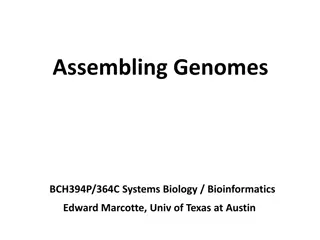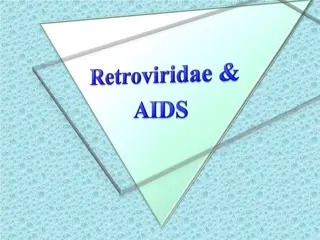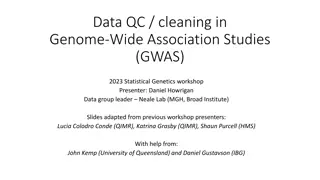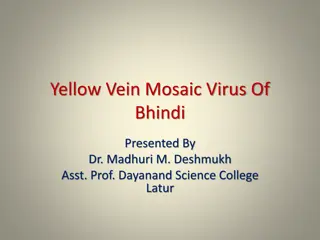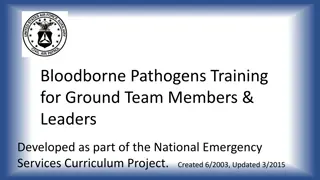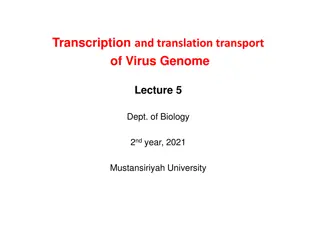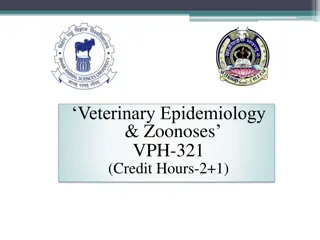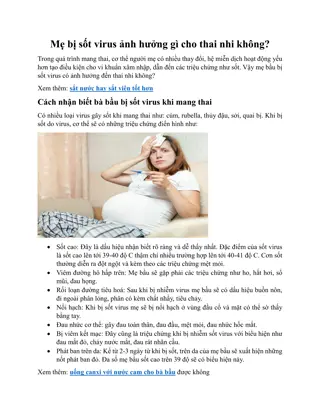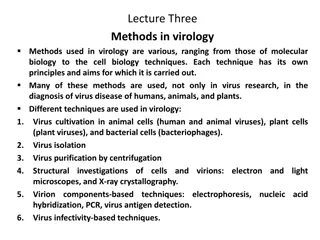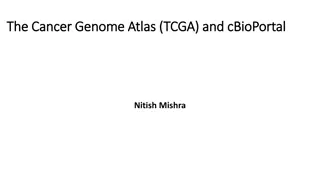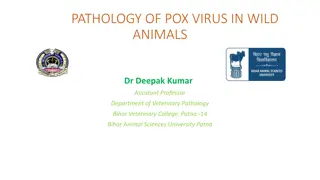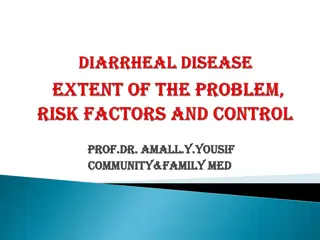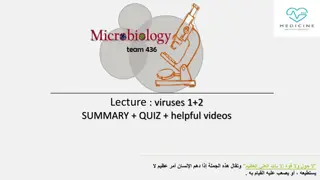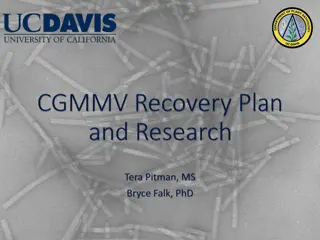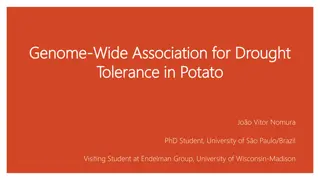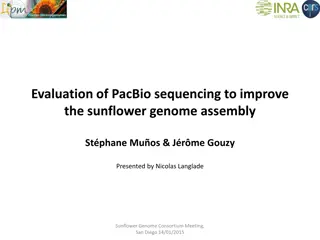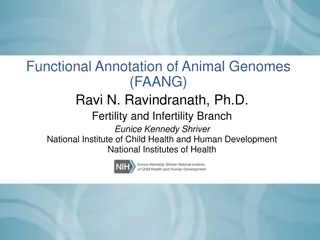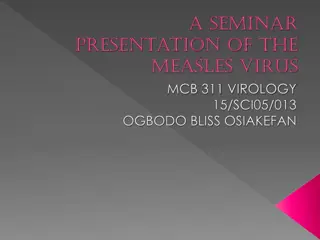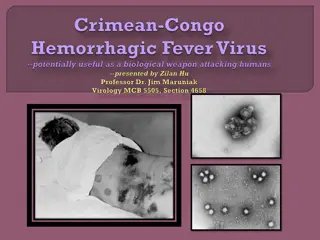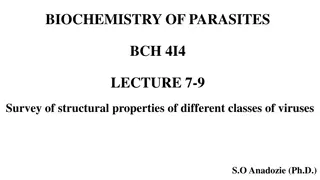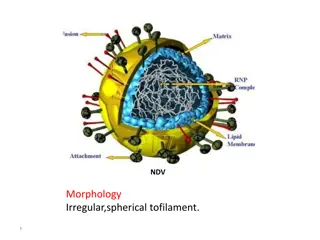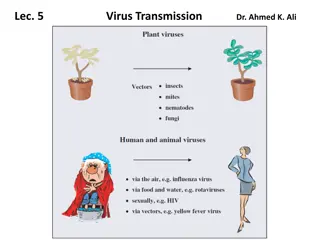Gene Therapy and Genome Editing Technology
This article provides insights into the status, regulatory considerations, and delivery methods of gene therapy and genome editing technologies. It discusses approved gene therapies in the US, human genome editing in clinical applications, and the regulatory authority of the FDA over gene therapy. T
2 views • 27 slides
Insights into Genome Assembly and Shotgun Sequencing
Explore the world of genome assembly, shotgun sequencing, and the fundamental concepts behind deriving genomes from large sets of sequencing reads. Learn about the complexity and core algorithms involved in contemporary genome assembly processes. Discover how the shotgun concept has revolutionized g
2 views • 66 slides
Human Immunodeficiency Virus
HIV, a member of the lentivirus subfamily of retroviruses, causes Acquired Immunodeficiency Syndrome (AIDS). HIV-1 and HIV-2 have distinct characteristics, with HIV-1 being global and HIV-2 primarily in West Africa. The virus encodes reverse transcriptase and has an envelope containing glycoproteins
1 views • 31 slides
Understanding Genome-Wide Association Studies in Statistical Genetics Workshop
Explore the essentials of Genome-Wide Association Studies (GWAS) and genetic data quality control as presented by Daniel Howrigan in the 2023 workshop. Delve into the goals of GWAS, genetic data characteristics, SNP variations, and genotyping techniques. Gain insights into moving from trait heritabi
0 views • 35 slides
Create a Virus Using Notepad: Dangerous Notepad Virus Codes
Learn how to create a virus using Notepad by following various dangerous virus codes such as creating fake Windows errors, stopping someone's internet access, and crashing a PC forever. Be cautious with these codes as they can cause serious harm to a computer system.
0 views • 10 slides
Understanding Yellow Vein Mosaic Virus of Bhindi
Yellow Vein Mosaic Virus of Bhindi, also known as Okra Yellow Vein Mosaic, is a viral disease caused by the Begomovirus, affecting okra plants. The disease manifests through symptoms like vein-clearing and vein-chlorosis of leaves, leading to yellow network patterns on the leaves and stunted, malfor
0 views • 14 slides
Bloodborne Pathogens Training Overview for Ground Team Members
Understanding bloodborne pathogens is crucial for ground team members to protect themselves and others. This training covers what bloodborne pathogens are, focusing on Hepatitis B Virus (HBV) and Human Immunodeficiency Virus (HIV), their symptoms, transmission risks, and prevention methods. HBV fact
0 views • 29 slides
Importance of Screening and Separation in Marburg Virus Disease Control
Early identification and separation of suspected Marburg virus disease patients play a crucial role in preventing the spread of the disease within healthcare settings. Screening and setting up specific areas for identification and isolation are essential steps to protect healthcare workers, patients
1 views • 15 slides
Understanding Transcription and Translation of Virus Genome
The lecture covers the transcription and translation processes of virus genomes, including the Baltimore classification system, transcription control in eukaryotes, and the role of transcription factors in gene expression. It explores how different viruses replicate based on their genome type and me
0 views • 14 slides
Understanding Rabies: A Comprehensive Overview
Rabies is an acute fatal disease affecting humans and warm-blooded animals, characterized by abnormal behavior, nervous disturbances, excessive salivation, and respiratory paralysis. It claims around 55,000 human lives globally, with efforts in rabies control showing marginal success. The etiology o
0 views • 22 slides
Mẹ bị sốt virus ảnh hưởng gì cho thai nhi không
M\u1eb9 b\u1ea7u b\u1ecb s\u1ed1t virus c\u00f3 \u1ea3nh h\u01b0\u1edfng \u0111\u1ebfn thai nhi kh\u00f4ng? Mang thai l\u00e0 giai \u0111o\u1ea1n nh\u1ea1y c\u1ea3m v\u00e0 m\u1eb9 d\u1ec5 b\u1ecb nhi\u1ec5m virus, vi khu\u1ea9n g\u00e2y s\u1ed1t.
0 views • 3 slides
Understanding OSHA Bloodborne Pathogens Training and Hepatitis B Virus
Covering the basics of OSHA Bloodborne Pathogens Standard, this training material provides essential information on bloodborne pathogens, including Hepatitis B Virus (HBV). It emphasizes the importance of training for individuals with occupational exposure, outlining crucial topics such as Hepatitis
2 views • 56 slides
Understanding a Complex KMT2A Rearrangement in AML with Optical Genome Mapping
A case report explores the use of optical genome mapping (OGM) to unravel a complex KMT2A rearrangement in an AML patient. Traditional cytogenetic analyses identified translocations and rearrangements involving chromosomes 10 and 11, leading to the fusion of genes KMT2A and MLLT10. OGM technique, ut
3 views • 5 slides
Overview of Virology Methods: Cultivation, Isolation, Purification
Various methods are employed in virology, including virus cultivation in different cells, virus isolation, and virus purification through centrifugation. Structural investigations, virion component-based techniques, and virus infectivity-based techniques are also common in virology research. Underst
0 views • 15 slides
Understanding the Cancer Genome Atlas (TCGA) Project
The Cancer Genome Atlas (TCGA) project, initiated in 2005, aims to identify genetic mutations in cancer through genome sequencing. Supervised by the Center for Cancer Genomics, TCGA has expanded over the years, publishing numerous research articles and involving various tumor types. The project has
0 views • 7 slides
Pathology of Pox Virus in Wild Animals by Dr. Deepak Kumar
Pox viruses can affect wild animals, with Monkeypox emerging as a significant zoonotic virus in Central and West Africa. The disease shows similarities to smallpox but is less severe. Pox lesions are characteristic signs of infection, and outbreaks have been documented in regions with a history of s
0 views • 16 slides
Understanding Feco-Oral Diseases and Diarrhea Transmission
Feco-oral diseases, primarily transmitted through the fecal-oral route, remain a significant global health concern, especially affecting children under 5 and the elderly. Diarrhea, characterized by WHO as three or more watery stools in 24 hours, poses a substantial burden, with infectious agents cau
0 views • 46 slides
Evaluating Genomic Science: Insight into Genome Canada's Mission and Impact
This conversation with Dr. Samantha Evans, Director of Evaluation at Genome Canada, delves into the importance of program evaluation in genomic science. Genome Canada aims to connect ideas, invest in science and technology, and maximize impacts across sectors. The evaluation process involves collect
0 views • 36 slides
Advancements in Genome Alignment and Sequencing Techniques
Genome alignment plays a crucial role in understanding biological processes and evolutionary history. With the rise of whole genome sequencing, methods such as constrained alignment and longest increasing subsequence have been employed for accurate variant detection. Tools like BLAST, hash tables, a
0 views • 11 slides
Viral Infections of the Respiratory System Lecture Summary & Quiz
This lecture covers viral infections of the respiratory system, focusing on Avian flu, Influenza Virus, Respiratory Syncytial Virus, Human metapneumovirus, Parainfluenza viruses, Measles, and Mumps virus. It includes information on the structure, symptoms, lab diagnosis, treatment, and prevention of
0 views • 11 slides
Understanding Zika Virus: Risks and Precautions
Zika virus is a mosquito-borne infection that can lead to birth defects and neurologic disorders. It spreads through mosquito bites and can also be transmitted from mother to child during pregnancy or through sexual contact. The virus is prevalent in South and Central America, the Caribbean, and is
0 views • 17 slides
Understanding Akabane Disease: Causes, Symptoms, and Prevention
Akabane disease, also known as Enzootic Bovine Arthrogryposis and Hydranencephaly, is a viral illness transmitted by arthropods that primarily affects calves, lambs, and kids. The disease can lead to congenital abnormalities such as joint immobility and absence of the cerebral hemisphere. It is caus
2 views • 19 slides
Understanding Cucumber Green Mottle Mosaic Virus: Disease Cycle and Testing Methods
This content provides detailed information on Cucumber Green Mottle Mosaic Virus, including its nucleotide genome, disease cycle, testing methods like DAS-ELISA and RT-PCR, seed testing protocols, bioassay for virus confirmation, and symptom expression in host plants. The data covers aspects such as
0 views • 14 slides
Genome-Wide Association for Drought Tolerance in Potato Study
PhD student João Vitor Nomura is conducting a Genome-Wide Association study for drought tolerance in potatoes at the University of São Paulo and the University of Wisconsin-Madison. The research focuses on adapting potato varieties to extreme heat waves and improving food security. Different abiot
0 views • 19 slides
Genome Sciences 373: Informatics Quiz, Python Dictionaries, and Conditional Statements Overview
Today's session covers topics such as Python dictionaries with in-class examples, iterating through dictionary entries, counting repeating characters in a string, and understanding if/elif/else statements. The session also includes a discussion on combining tests in Python and comparisons operators.
0 views • 41 slides
Understanding Avian Influenza: Symptoms, Diagnosis, and Prevention
Avian influenza, or bird flu, is a viral disease affecting birds' respiratory, digestive, and nervous systems. It presents in two forms - Highly Pathogenic Avian Influenza Virus (HPAIV) and Low Pathogenic Avian Influenza Virus (LPAIV). The virus has two important surface antigens, Hemagglutinin (H)
0 views • 7 slides
Understanding Genetic Disorders and the Human Genome Project
The Human Genome Project, completed in 2003, aimed to identify all human genes and DNA sequences. Genetic disorders, like autosomal disorders and Huntington's disease, can result from mutations at different levels, affecting single genes, chromosomes, or multiple genes. Albinism and cystic fibrosis
0 views • 37 slides
Evaluation of PacBio Sequencing to Improve Sunflower Genome Assembly
Presentation at the Sunflower Genome Consortium Meeting in San Diego discussed the use of PacBio sequencing to enhance the sunflower genome assembly, with evaluations on PacBio data's effectiveness at locus and genome scales. Results highlighted challenges and successes in improving assembly quality
0 views • 15 slides
Overview of Bovine Viral Diarrhea Virus (BVDV)
Bovine Viral Diarrhea Virus (BVDV) is an RNA virus belonging to the Pestivirus genus in the Flaviviridae family. It is classified into BVDV-1 and BVDV-2 genotypes with distinct biotypes. BVDV is a significant infectious disease in the livestock industry worldwide, with high prevalence and clinical c
0 views • 14 slides
GenPIP: In-Memory Acceleration of Genome Analysis
GenPIP is an innovative system that accelerates genome analysis through tight integration of basecalling and read mapping. By utilizing chunk-based pipelines and early rejection techniques, GenPIP optimizes data processing, reducing wasted computation and data movement. The system outperforms existi
0 views • 28 slides
Importance of Functional Annotation of Animal Genomes in NIH Research
Functional Annotation of Animal Genomes (FAANG) is crucial for associating sequence variation with quantitative phenotypes in domestic animals, serving as important models for human health, disease, and ecology. The NIH actively participates in various genome projects involving cattle, horses, and c
0 views • 10 slides
Understanding Measles Virus: A Comprehensive Seminar Presentation
The measles virus, also known as rubeola or morbilli virus, is a highly contagious infection that primarily affects the respiratory system. This presentation delves into the classification, characteristics, and pathogenesis of the virus, shedding light on its structure, transmission, and impact on p
0 views • 24 slides
Understanding Anti-Anti-Virus Techniques and Retroviruses
Explore the world of anti-anti-virus techniques including Retroviruses and Entry Point Obfuscation. Learn about the methods used by viruses to evade detection and damage anti-virus software. Discover how Retroviruses like Ganda virus operate stealthily to hinder anti-virus programs. Delve into strat
0 views • 24 slides
Decades of Marine RNA Virosphere Research
Research spanning over two decades has delved deep into the marine RNA virosphere, shedding light on the complex marine ecosystem and the characteristics of RNA viruses. Discoveries in deep marine virus taxonomy have led to significant taxonomic changes and advancements in virus classification and g
0 views • 10 slides
Overview of Crimean-Congo Hemorrhagic Fever Virus
Crimean-Congo Hemorrhagic Fever (CCHF) virus is an RNA virus belonging to the genus Nairovirus, causing a zoonotic disease with high mortality rates in humans. The virus is transmitted mainly by ticks, particularly the Hyalomma species, and can result in severe illness in both domestic and wild anim
0 views • 17 slides
Survey of Structural Properties of Different Classes of Viruses
Viruses are small obligate intracellular parasites that require living hosts for multiplication. They lack ribosomes and metabolic enzymes, relying on host cells for replication. Viruses vary in size, shape, and genome organization, with classification based on morphology, physicochemical properties
0 views • 31 slides
Understanding the Morphology and Genome Organization of NDV
NDV, a pleomorphic virus, has an irregular spherical shape with filamentous features. Its genome consists of a single-stranded RNA with six genes arranged in a specific order. The virus contains a lipoprotein envelope with short spikes and a helical nucleocapsid core to protect the RNA. The genomic
0 views • 35 slides
Understanding Chicken Pox: A Seminar on the Medical Importance of Viruses
Chicken pox, caused by the Varicella-zoster virus, is a contagious infection primarily affecting children. This seminar presentation delves into the classification, route of infection, symptoms, and treatment of this viral disease common in Africa. The Varicella-zoster virus, a member of the herpes
0 views • 17 slides
Understanding GWAS: A Brief Overview of Genetic Association Studies
GWAS, or Genome-Wide Association Studies, are a method used to map genes associated with traits or diseases by analyzing genetic markers throughout the genome. This process involves statistically testing the association between SNPs and traits using regression or chi-squared tests in a hypothesis-fr
0 views • 19 slides
Understanding Virus Transmission via Vectors in Hosts
Viruses must be propagated and transmitted to new hosts for survival. They can be spread via vectors like arthropods, which acquire and transmit viruses during feeding. This transmission can occur quickly through the vector's mouthparts or more slowly via circulation in the vector's body. Plant viru
0 views • 14 slides

